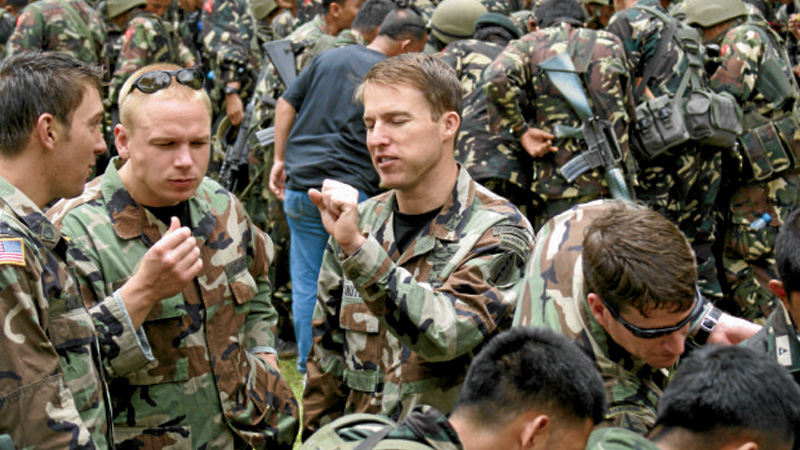
BOODLE FIGHT US Army soldiers join members of the Philippine Army’s 103rd Brigade in a boodle fight in this photo taken in 2008 in celebration of a successful peacekeeping mission in Lanao del Sur province. —RICHEL V. UMEL
SUMISIP, Basilan—US troops are staying despite President Duterte’s pronouncement that they should leave Mindanao.
Lt. Gen. Mayoralgo dela Cruz, chief of the Western Mindanao Command, said on Monday that while it was true that some US soldiers had left a few weeks ago, they were immediately replaced.
“These are normal rotation. Those who have left were US Marines and they were replaced by US Army soldiers. Definitely, the marines will bring back their own equipment,” he said.
Dela Cruz said US forces were still present at the command headquarters in Zamboanga City, across the channel from Basilan province, and “there are 107 (of them).”
Everybody present
“All of them are still here,” said the official, who was in Sumisip to accept the surrender of 32 Abu Sayyaf bandits in a ceremony at the town hall.
US troops maintain a small camp inside the Western command headquarters. The Americans have been training their Filipino counterparts on such skills as humanitarian and medical evacuation, including mobile treatment of wounded soldiers.
Dela Cruz said there had been no directive for the withdrawal of US troops from the area. “If there is an order to withdraw, the first ones to know are those in Manila,” he said.
Ambassador Philip Goldberg said on Tuesday the security threat in the conflict-plagued region was “very serious,” warning the Islamic State (IS) was among a number of foreign militant organizations trying to increase its involvement there.
US concern
“We’ve helped the Philippines as it has reduced the threat over time,” Goldberg told ABS-CBN television.
“But we are concerned obviously about any new intrusion of IS or any other group that wants to take advantage of open space in the south of the Philippines. So we want to continue doing that,” he said.
The United States had deployed from 2002 to 2014 a rotating force of about 600 troops to Western Mindanao to train local soldiers in how to combat Islamic militants.
The presence was scaled down after the United States deemed the militants there had “largely devolved into disorganized groups resorting to criminal undertakings,” according to a US statement in 2014.
Islamic militant attacks spiked after that, most prominently with the homegrown Abu Sayyaf group abducting dozens of foreigners and locals to extort ransoms.
About 100 American troops remain in the South, Goldberg said on Tuesday.
But Mr. Duterte, who took office on June 30, has said the US troops are adding to tensions with the Islamic communities in the southern region of Mindanao.
“These US Special Forces, they have to go in Mindanao,” he said last month.
Mr. Duterte, who describes himself as a socialist and part Muslim, has called for the ejection of American troops as part of a general effort to dilute his nation’s 70-year alliance with the United States.
Separatist insurgency
Islamic militants have waged a decades-long separatist insurgency in Mindanao that has claimed more than 120,000 lives. The region is the ancestral homeland of the Muslim minority in the mainly Catholic Philippines.
The major rebel organizations are no longer waging armed struggle, but hardline splinter groups such as the Abu Sayyaf have remained a threat.
Goldberg warned that Jemaah Islamiyah, a Southeast Asian group responsible for the deadly 2002 bombings on the Indonesian resort island of Bali, and other foreigners were in Mindanao.
“This is a very serious issue,” Goldberg said. “We are not just dealing with the Abu Sayyaf but groups from the region like Jemaah Islamiyah. We see increasing efforts from IS to become involved.” —WITH A REPORT FROM AFP